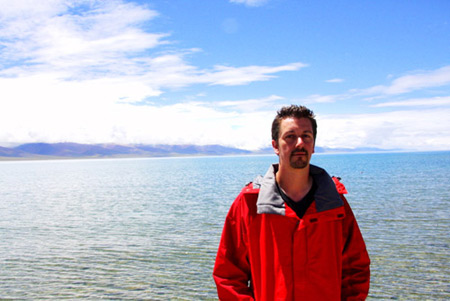Paul's Tibet journal: heavenly lake
2009-09-29 17:19 BJT
By Paul James
BEIJING, Aug. 27 -- When the alarm went off at 6:45 Wednesday morning, to say that I was lamenting the day‘s set activity would be an understatement. Not as though I have any aversion to checking out new and interesting sites, but after spending at least two-fifth‘s of our trip in a vehicle heading from destination to destination, the prospect of another 10 to 12 hours in a vehicle wasn‘t sitting well with me, or my aching knees.
But putting aside my apprehensions, I bit my lip and got into the SUV for our five-hour drive to Tian Hu, or Heavenly Lake. The second of the three sacred lakes in Tibetan culture we‘ve seen in as many days, Tian Hu lies approximately 230 kilometers northwest of Lhasa.

CRI reporter Paul James poses for a photo at Namtso Lake. (Photo:CRIENGLISH.com)
Setting out on the day‘s trip, our first obstacle to overcome was the huge caravan of PLA vehicles easily stretching 10 kilometers. After weaving our way in and out of the troop carriers on the two lane highway, we managed to start making reasonable time.
Much to my relief, the road to Tian Hu is relatively flat and cut into a somewhat benign mountain pass which is also home to the Qinghai-Tibet rail line, which means fewer sharp curves and no real steep cliffs to look over and ponder one‘s own mortality. The only real curvy, mountainous area on the trip is the mountains that mark the start of the protected area, some 5,170 meters above sea level. After winding your way down the other side of the mountain, the landscape opens up into lush grassland inhabited by local herders raising sheep, cattle and Tibetan yak.
Namtso Lake, as it is known in the Tibetan language, stretches out for dozens of kilometers down the wide valley and boasts a surface area of 1,940 square kilometers, but the main congregating area is about 20 kilometers from the crechendo of the mountain.
Upon reaching the main area, you‘re greeted by what appears almost to be a shantytown-like collection of temporary, prefabricated structures which act as restaurants, shops and even hotels.
After parking, we quickly determined that we were not going to be staying at Tian Hu very long, as we still had to make the return trip to Lhasa. And quite frankly, that suited me just fine. Even though the day‘s adventure is tantamount to taking a flight from Beijing to Hong Kong, getting off, having a hot dog, then getting on the next flight back to Beijing (and you had already eaten a hot dog yesterday; See: Yangzhuoyongcuo Lake from Tuesday), I was willing to put those thoughts aside and enjoy the scenery and while at the same time not belaboring the point. After we ran the gauntlet of panhandlers which have congregated to ply their trade on the tourists, we reached the edge of the lake itself.
And even though you can see the lake from the peak of the mountains, it must be said that being next to it is a much more pleasurable experience. The crystal clear water stretches out as far as the eye can see and the shoreline to the north winds its way around next to the hills. The shore even has fine sand, which is not what you might expect from a lake tucked away in the mountains some 4,718 meters above sea level.
Aside from the panhandlers, there were also yak owners there who, for a price of course, will allow you to get on the back of one of their somewhat diminutive beasts, which will then be backed into the lake up to the yak‘s thighs for the photographic opportunity.
Aside from the lake, there are also a pair of large rock outcroppings which act as anchors for the hundreds of multi-colored Tibetan luck flags already strung up and also readily available for purchase as well. And while Tian Hu has all the hallmarks of a tourist trap, it still maintains a religious component to it, with prayer wheels lining the route to and from the shore.
There were also a couple of local monks there as well, presumably there to give homage to the lake. In fact, the lake is said to bring good fortune to the families of those who, in the year of the sheep, circle the entire lake once and go around Tuechun Island, which is part of the lake, a dozen times. One presumes that even if the entire family failed to gain eternal bliss, at least they‘d get back a family member in much better physical health!
At 80 kuai a pop for admission, the Heavenly Lake, which-as an aside -claims to be the highest salt water lake in the world, is definitely worth a trip if one finds themselves with a free day while in the Lhasa area. As for myself, eight days of straight travel in the Tibetan highlands is starting to take a mental toll. But much like any long trip one takes, it is the retrospect once back in Beijing that will give me pause to be thankful I "played through the pain."
Editor: 卢佳颖 | Source: CRIENGLISH. com

 Mail
Mail Share
Share Print
Print


 Video
Video









 2009 China Central Television. All Rights Reserved
2009 China Central Television. All Rights Reserved